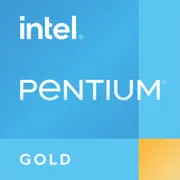Intel Pentium Gold 4415U

Intel Pentium Gold 4415U: Budget-Prozessor für alltägliche Aufgaben
April 2025
Architektur und Fertigungsprozess: Kaby Lake in der Ära der Miniaturisierung
Der 2017 eingeführte Prozessor Intel Pentium Gold 4415U auf der Architektur Kaby Lake ist nach wie vor in Budget-Laptops zu finden. Seine wichtigsten Merkmale:
- 2 Kerne und 4 Threads dank Hyper-Threading.
- Basis-Taktfrequenz: 2,3 GHz (Turbo-Modus fehlt).
- 14-nm Fertigungsprozess, der im Jahr 2025 im Vergleich zu 5-nm-Chips von Apple und 4-nm-Lösungen von AMD veraltet erscheint.
- Integrierte Intel HD 610 Grafik: 12 Ausführungseinheiten, Taktfrequenz von bis zu 950 MHz.
Die Architektur Kaby Lake ist für Energieeffizienz optimiert, jedoch nicht für Multithreading-Belastungen. Der integrierte GPU bewältigt die Decodierung von 4K-Videos (HEVC, VP9), ist aber nicht für 3D-Rendering ausgelegt.
Energieverbrauch und TDP: Balance zwischen Leistung und Autonomie
Die TDP des Prozessors beträgt 15 W, was den Einsatz in schlanken Notebooks mit passiver oder kompakter aktiver Kühlung ermöglicht. Beispielsweise benötigen Geräte wie das Lenovo IdeaPad Slim 3 (Gehäusedicke – 17,9 mm) nur minimalen Platz für Kühler und Ventilator.
Der Vorteil dieses Ansatzes ist der geringe Geräuschpegel: Selbst unter Last dreht der Ventilator selten hoch. Allerdings schränkt das Fehlen eines Turbo-Modus die Spitzenleistung ein.
Leistung: Was kann der Pentium Gold 4415U im Jahr 2025?
Büroarbeit und Multimedia
- Browser: 5-7 Tabs in Chrome + YouTube 1080p – reibungslose Arbeit, jedoch mit gelegentlichen Rucklern.
- Dokumente: Microsoft Office, Google Workspace – problemlos.
- Video: Streaming in 4K (Netflix, YouTube) – stabil, dank des iGPU-Decoders.
Gaming
- CS:GO: 720p, niedrige Einstellungen – 25-30 FPS.
- Minecraft: 30-40 FPS in Standard-Szenarien.
- Indie-Spiele (Hollow Knight, Stardew Valley) – komfortabel spielbar.
Für Spiele ist dedizierte Grafik wichtig, jedoch fehlt diese in Laptops mit Pentium Gold 4415U in der Regel.
Nutzungsszenarien: Für wen ist dieser Prozessor geeignet?
- Studierende: Arbeiten mit Vorlesungen, Online-Kurse, Zoom.
- Büromitarbeiter: Dokumente, E-Mail, Videokonferenzen.
- Heimanwender: Surfen, Streaming, einfacher Fotobearbeiter (z.B. Canva).
Nicht geeignet für:
- Videobearbeitung (Premiere Pro, DaVinci Resolve).
- Anspruchsvolle IDEs (Android Studio, Unity).
- Moderne AAA-Spiele.
Autonomie: Wie lange hält der Laptop durch?
Bei einer Batteriekapazität von 40-50 Wh (typisch für Ultrabooks mit Pentium 4415U) beträgt die Betriebszeit:
- 8-10 Stunden bei Dokumentenarbeit + Wi-Fi.
- 5-6 Stunden bei Streaming von Video (YouTube 1080p).
Energiespartechnologien:
- Intel Speed Shift: Dynamische Frequenzregelung.
- C-States: Deaktivierung ungenutzter Kerne.
- Panel Self Refresh: Reduzierung der GPU-Belastung bei statischen Bildern.
Vergleich mit Mitbewerbern: Wo steht der Pentium Gold?
1. AMD Athlon Silver 3050U (2 Kerne/2 Threads, Vega 2 GPU):
- In Multithreading-Aufgaben schwächer, aber die Grafik ist besser.
2. Apple M1 (8 Kerne, 5 nm):
- 3-4 mal höhere Leistung, jedoch starten die Preise für Laptops bei 800 $.
3. Intel Core i3-1115G4 (Tiger Lake, 10 nm):
- 30-40% schneller, jedoch mit TDP von 15-28 W.
Fazit: Der Pentium Gold 4415U ist nur im Segment von 300-400 $ relevant, wo der Preis entscheidend ist.
Vor- und Nachteile: Sollten Sie kaufen?
Stärken:
- Niedriger Preis der Laptops (ab 300 $).
- Kühle und leise Betriebsweise.
- Unterstützung für 4K-Video.
Schwächen:
- Kein Spielraum für zukünftige Betriebssysteme und Anwendungen.
- Langsame SSD oder eMMC in Basiskonfigurationen.
- Eingeschränkter Upgrade (RAM ist oft verlötet).
Empfehlungen zum Laptop-Kauf
1. Gerätetyp: Ultrabook oder kompakter Laptop (z.B. ASUS Vivobook Go 14).
2. Arbeitsspeicher: Mindestens 8 GB (besser DDR4-2400).
3. Speicher: Unbedingt SSD (256 GB NVMe).
4. Bildschirm: Full HD (IPS-Display für angenehmen Betrachtungswinkel).
5. Ports: USB-C, HDMI zur Anschluss von Monitoren.
Preise im Jahr 2025:
- Basismodelle – 300-350 $.
- Versionen mit SSD und 8 GB RAM – 400-450 $.
Zusammenfassendes Fazit: Für wen ist der Pentium Gold 4415U geeignet?
Dieser Prozessor ist die Wahl für diejenigen, die:
- einen maximal günstigen Laptop für grundlegende Aufgaben suchen.
- lange Akkulaufzeit und Portabilität schätzen.
- nicht planen, ressourcenintensive Anwendungen zu nutzen.
Wichtige Vorteile:
- Verfügbarkeit.
- Energieeffizienz.
- Ausreichende Leistung für den Alltag.
Wenn das Budget es zulässt, 100-200 $ mehr auszugeben, ist es ratsam, ein Laptop mit einem Intel Core i3/i5 der 12. Generation oder AMD Ryzen 3 7300U zu wählen – diese werden länger relevant bleiben.
Basic
CPU-Spezifikationen
Speicherspezifikationen
GPU-Spezifikationen
Verschiedenes
In sozialen Medien teilen
Oder verlinken Sie uns
<a href="https://cputronic.com/de/cpu/intel-pentium-gold-4415u" target="_blank">Intel Pentium Gold 4415U</a>